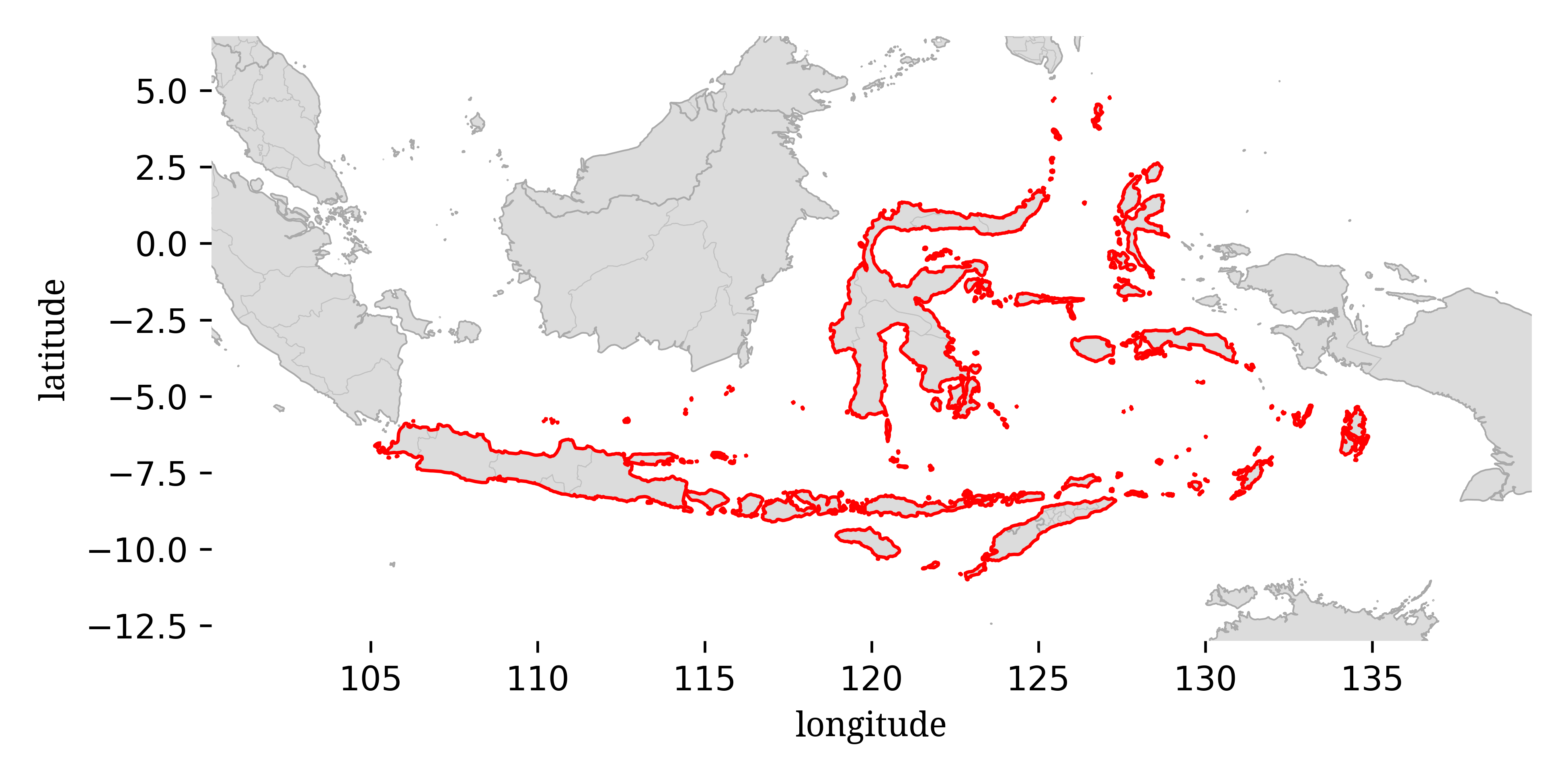
This guide is designed for identification “in the field” where you might be looking at live crabs by eye or through binoculars or from photographs. I will generally try to avoid characters that will require you to physically catch the crab, although I may mention a few for secondary verification. It does not include the more strict taxonomist-style characters that may only be visible under a microscope or via dissection. It is also assumed that the individuals are living, as death (and even capture) can cause dramatic color change.

This is a guide to the fiddler crabs of central Indonesia, essentially all of Indonesia other than the largest islands, Sumatra and Borneo in the west and New Guinea in the east. It also includes the country of East Timor. This region may have as many as 14 species present:
In addition to these, there have been some reports of Austruca mjoebergi is southern Sulawesi. I am leaving this species out of the guide at this time as it may be extremely rare, if present at all.
A number of features can be used to distinguish among these species, but a good place to start is to look at the distance between the base of the eyestalks. Fiddler crabs tend to split into two groups, those with the eyestalks very close together (“narrow front”) and those with the eyestalks separated a bit more (“broad front”). Five of these species (Austruca annulipes, Austruca cryptica, Austruca perplexa, Austruca triangularis, and Paraleptuca crassipes) are broad front species, while the other nine (Gelasimus jocelynae, Gelasimus tetragonon, Gelasimus vocans, Tubuca bellator, Tubuca coarctata, Tubuca demani, Tubuca dussumieri, Tubuca forcipata, and Tubuca typhoni) are narrow front species. Note that the carapace between the eyestalks appears pinched together in the narrow front species, but more trapezoidal in the broad front species.
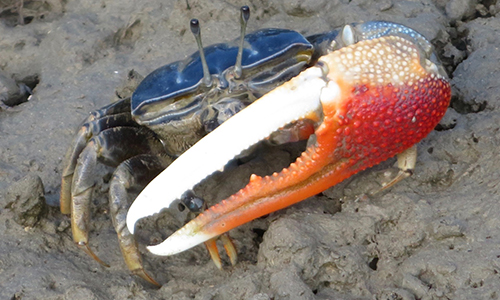
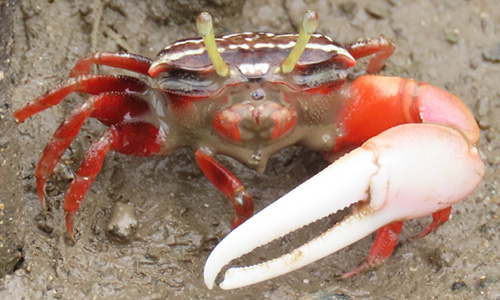
Austruca perplexa can be highly variable across its range. It has a carapace that is generally black and white, frequently with moderately distinct striping; its carapace usually leans more toward black than white, but more solid colros, including almost solid white are possible. Its large claw is tends to be a mix of yellow and white, but can also be a solid color of either. Its legs are usually white or brown or yellow; very rarely red.
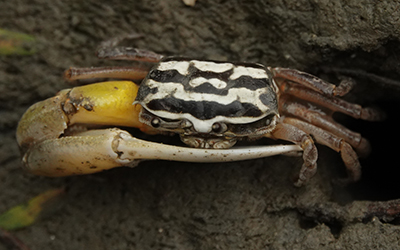
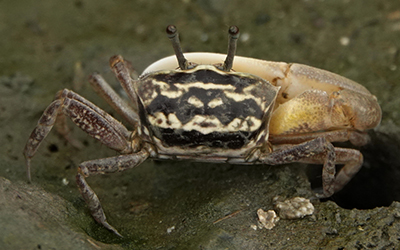
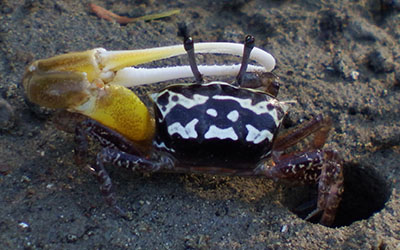
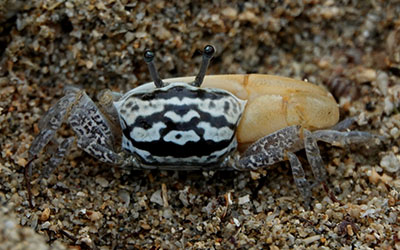
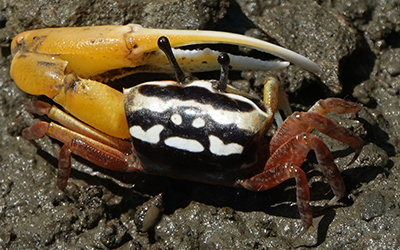
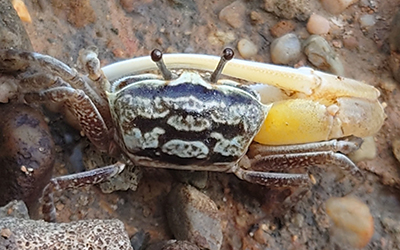
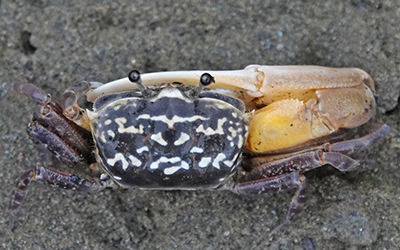
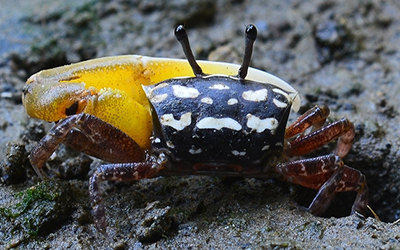
Austruca annulipes is a common, wide-spread species that is very similar to Austruca perplexa. Generally, the carapace of Austruca annulipes tends to be a mix of black and white. The large arm of Austruca annulipes is generally orange or red, with some of the color frequently found on the hand of the claw as well.
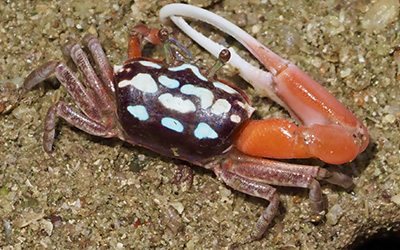
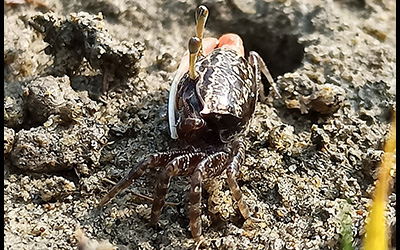
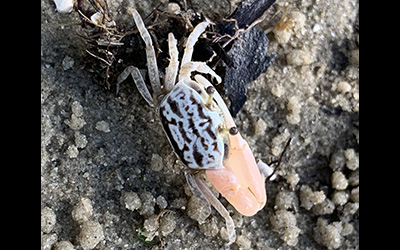
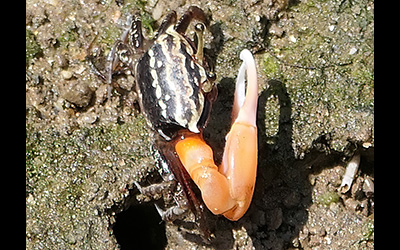
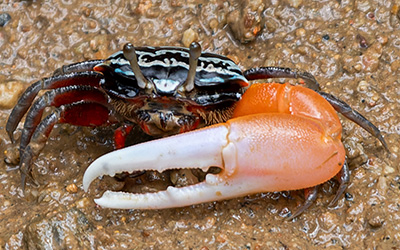
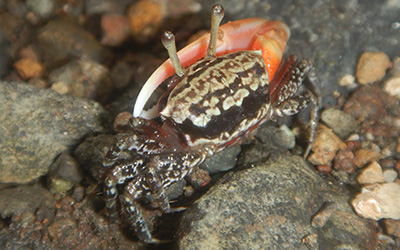
Color is the easiest way to distinguish this species from Austruca perplexa, as Austruca annulipes tends to have a reddish arm and claw, rather than yellow or white, but entirely white claws do sometimes occur.
Austruca cryptica is an extremely obscure species that was originally identified from museum specimens, with living individuals only observed a single time. From these limited observations, it is all but identical in appearance to Austruca annulipes and there are no known methods of distinguishing them in the field. It is possible that many observations of Austruca annulipes within the overlapping range are actually Austruca cryptica, but it is currently impossible to know.
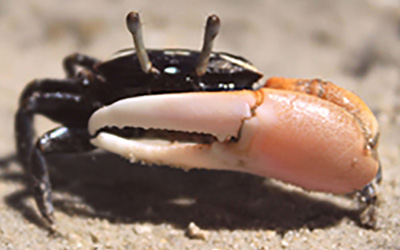
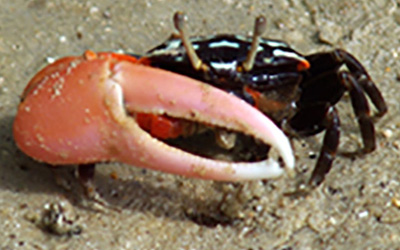
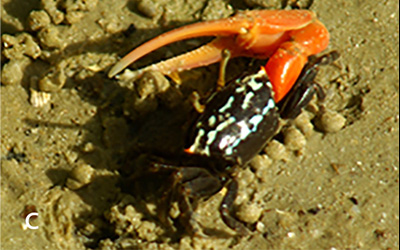
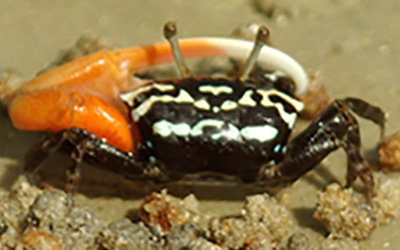
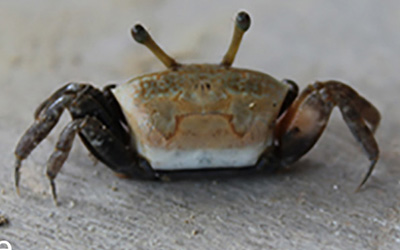
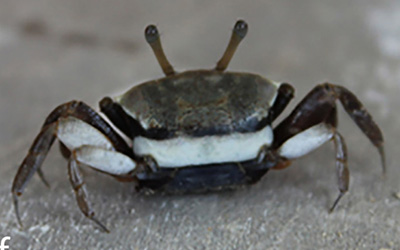
One thing to note: the areas where Austruca cryptica has been reported in the scientific literature (Philippines: Bohol and Mindanao; Indonesia: southeastern Sulawesi and western Flores) appear to be right at the eastern edge of the range of Austruca annulipes, at least based on iNaturalist observtions. It is possible that all of the easernmost "annulipes" are actually Austruca cryptica, although I wouldn't rely on that for identification purposes without more directed research into the differences and precise ranges of both species.
Austruca triangularis is superficially similar in color to both Austruca annulipes and Austruca perplexa, generally having a black/brow and white/cream carapace (occasionally yellow), frequently will broad stripes, and a claw which tends to be off white, but may include yellow. Despite this general similarity, the species should be relatively easy to tell apart.
There are at least three features which can be used to distinguish them. First, the carapace shape is noticably different, with the front corners of the carapace of Austruca triangularis extremely pointy and tending to point more toward the sides than the front, with the sides of the carapace converging much more strongly in Austruca triangularis than in either Austruca lactea or Austruca perplexa. Second, the hand of the large claw in Austruca triangularis is generally covered with brown spots, giving it a polka-dotted appearance (these spots are sometimes foundon the carapace as well). Third, but more subtle, on average Austruca triangularis tends to be smaller than the other two species, although there is overlap in size.
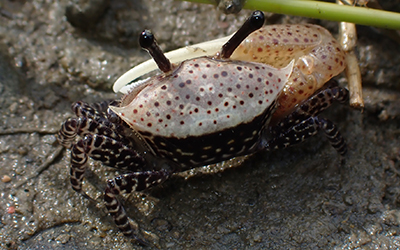
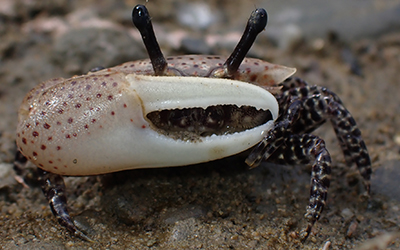
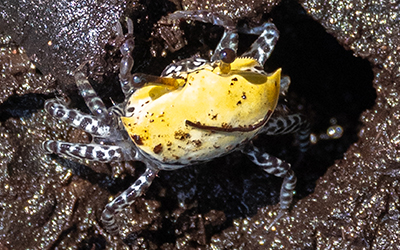
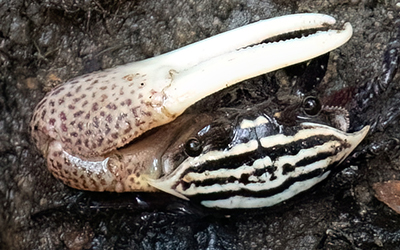
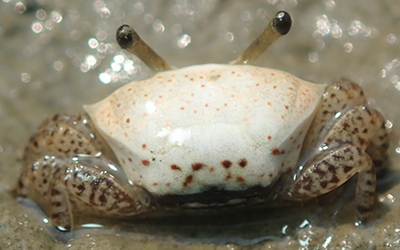
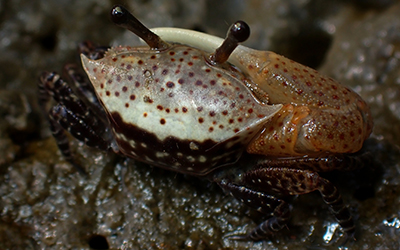
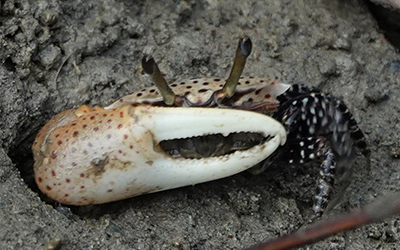
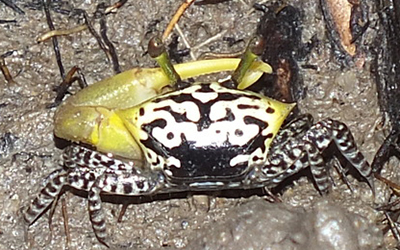
The final broad front species in this region, Paraleptuca crassipes is easily distinguishable from the others by color. The colors of Paraleptuca crassipes do overlap with one of the narrow front species, Tubuca coarctata, described below.
Paraleptuca crassipes is a highly variable species with a carapace that is generally some combiantion of black, pale blue, and bright red—occasionally with a hint of yellow or green—with solid red and all-but-solid black carapaces not uncommon (it seems never to be solid blue). It's eyestalks are usually yellow-green, but sometimes red, particularly in individuals with heavily red carapaces. The large claw is bright red-to-reddish pink, with paler pink or white fingers.
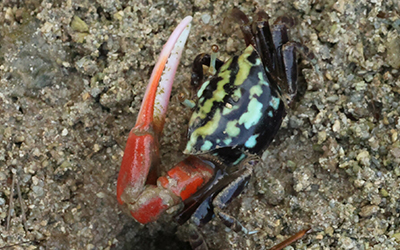
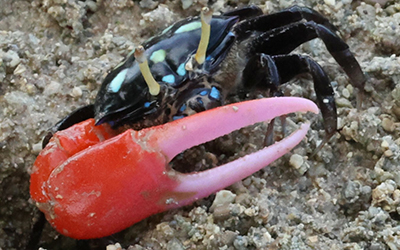
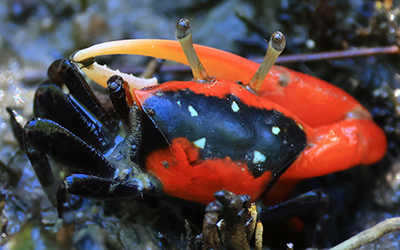
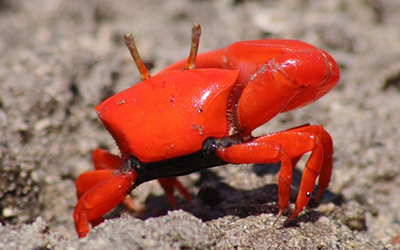
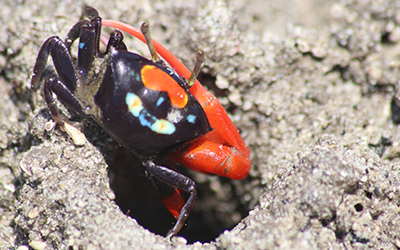
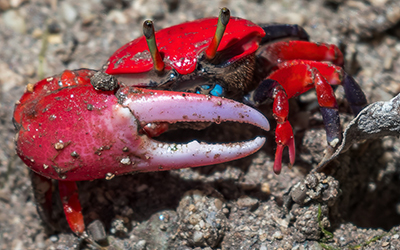
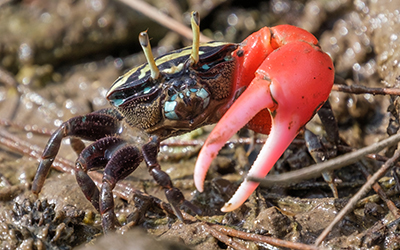
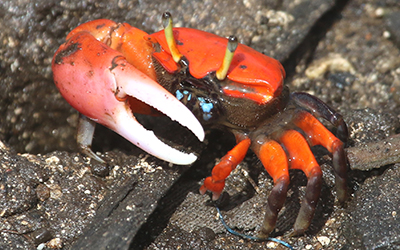
Gelasimus tetragonon is a wide-spread species that is something of an oceanic island specialist, although it is occasionally found on continental shores. It usually has a predominantly blue and black carapace with bright red legs (which occasionally may be darker) and gray eyestalks. The large claw of Gelasimus tetragonon is usually orange, with a noticeably darker red spot near the base of the pollex, and a white dactyl. Gelasimus tetragonon frequently has brown spots on the top part of the hand of the claw.
Gelasimus tetragonon has a lot of additional variability. In some places the carapace can lighten so that there is almost no blue, just a cream or pale orange with black markings. The pattern of the colors on the carapace can vary from stripes or blotches to tiny spots.
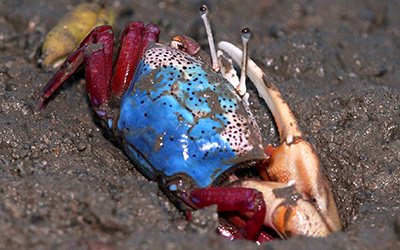
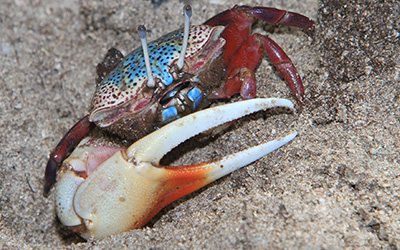
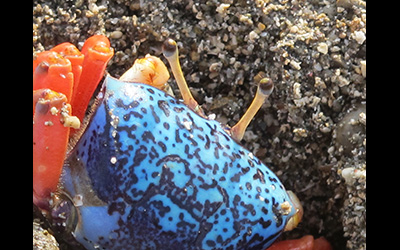
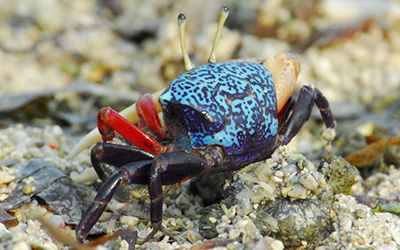
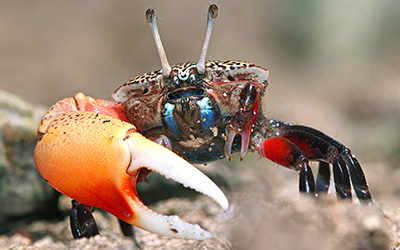
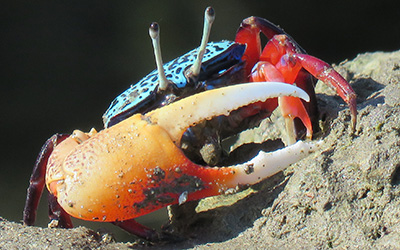
Tubuca forcipata is one of the more variable and confusing species, with multiple color forms that are not particularly similar to each other. One expert on fiddler crabs from the region has suggested that the name currently encompasses multiple, undescribed species being mixed together, but the formal work to determine if this is true and disentangle the various forms has not been completed at this time.
What I would refer to as the canonical form of Tubuca forcipata is a fiddler crab with a dark carapace with pale speckling (either white or pale blue) and a large claw where all or most of the hand is dark purple with the rest of the claw white. The claw is frequently heavily toothed and the tips of the fingers of the large claw often appear to come together as forceps, giving the species its name.
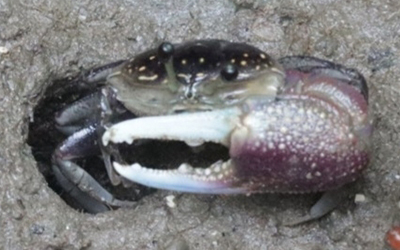
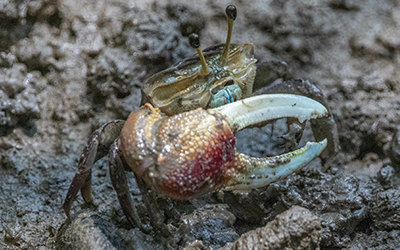
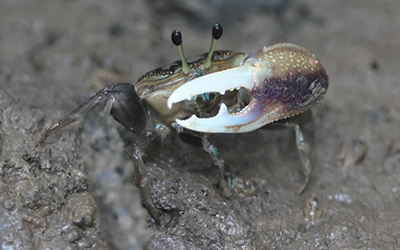
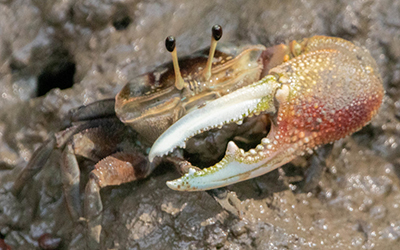
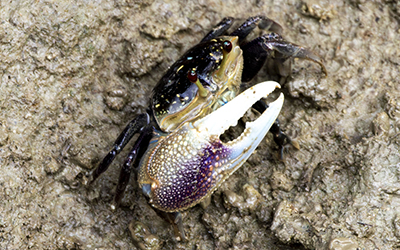
The second color form of Tubuca forcipata is completely different, with the crab a mix of black and bright red, generally with the black on the back half of the body and red on the front half, including the entire claw. The literature suggests that this bright red form is common in juveniles or yournger crabs of this species.
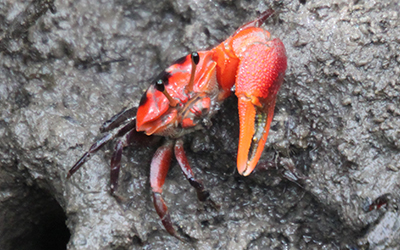
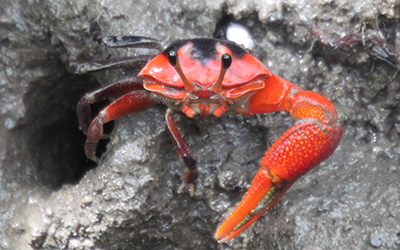
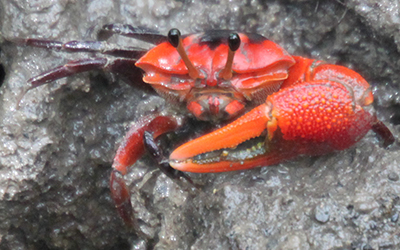
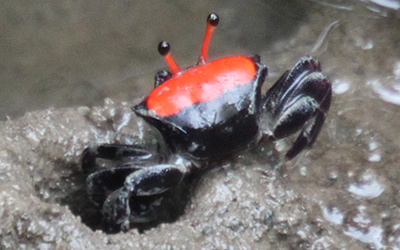
A third color form of Tubuca forcipata is vaguely in between the previous two, although not particularly similar to either of them. In this form, the carapace is generally black with large tan/beige patches toward the front, the legs are frequently pale gray, and the large claw has a dark red hand with orange fingers.
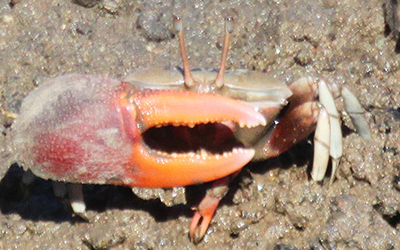
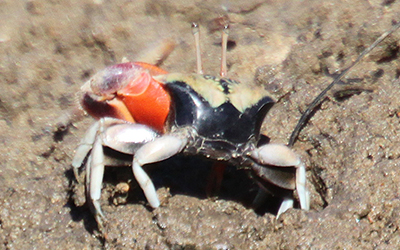
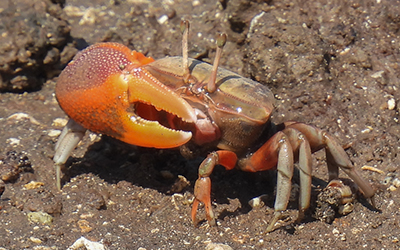
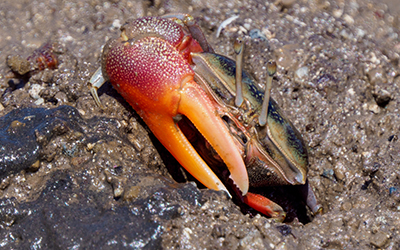
Are these all the same species? Maybe. It could simply be a variable species, the differences might represent age or developmental stage or regional variation. There are some additional patterns beyond color that separate these forms, particularly the first and third. The claw on the first form is notably toothier than the other two. The first and third form appear to have no geographic overlap, with the third form only appearing in the southeastern part of the Malay Archipelago (starting from Bali and including various islands further to the east and south), while the first form is only found further north and west (Borneo, Sumatra, etc.). Conversely, the black and red form (which has been suggested as representing a juvenile stage) overlaps with both of the other two in space, at least in part, as it has been seen from Bali (although not necessarily further south or east) to Singapore and the Malay peninsula.
Tubuca coarctata is a highly variable narrow front species that is most likely to be confused in this region with Tubuca dussumieri or the broad front species Paraleptuca crassipes. Differences between Tubuca coarctata and Tubuca dussumieri will be described below, so this section will focus more on Tubuca coarctata vs Paraleptuca crassipes. On average, front breadth might be the easiest way to distinguish these as the high variaiblity of both species creates a lot of general overlap in color pattern.
The most common carapace pattern in Tubuca coarctata is a mostly black carapace with some spots of pale blue, yellow, red, or white. In many cases, however, individuals may have carapaces that appear nearly solid of any of these colors or consist more of two-toned stripes of two of these colors (the latter pattern might be more common in females than males).

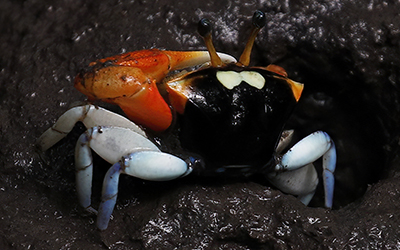
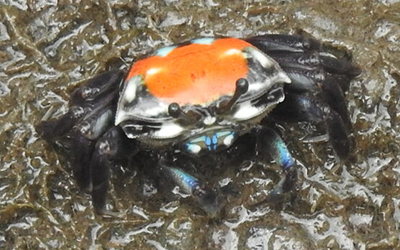
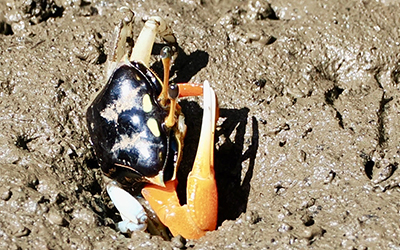
The legs of Tubuca coarctata generally follow this same color variation as the carapace, although the two rear legs generally have a large distinct, pale blue (sometimes almost white) blotch on the rear of the the top segment. This color will sometimes spread beyond this segment.
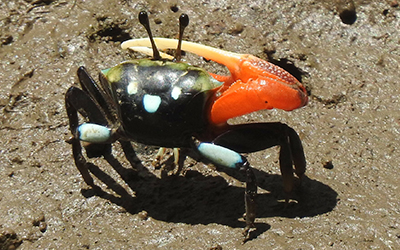
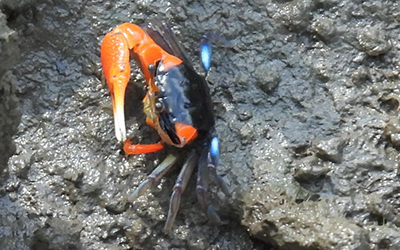
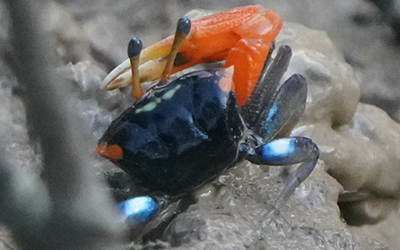
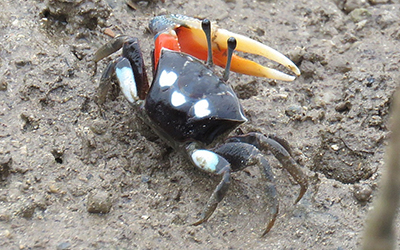
The large claw usually has a red or orange hand, with most of the upper finger and the outer half of the lower finger white. Sometimes the white will bleed further onto the upper part of the hand. There is also usually a darker red patch at the base of the lower finger (as is common in many other species). The prototypical male Tubuca coarctata has a distinct an obvious flat edged projection along the lower portion of the tip of the upper finger of the large claw. In some individuals this feature is more subtle, while other species may have a claw shape that is at least somewhat similar, although within this region this shape is more-or-less unique to this species.
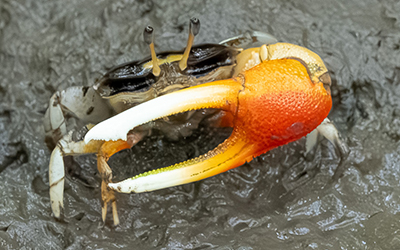
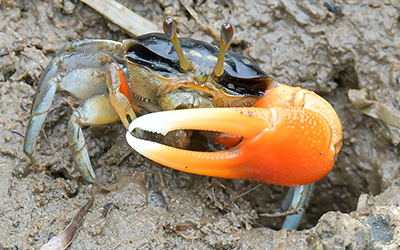
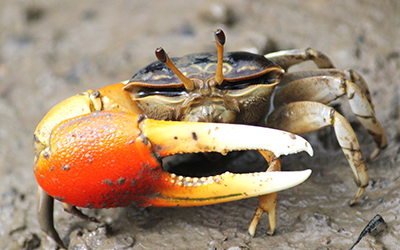
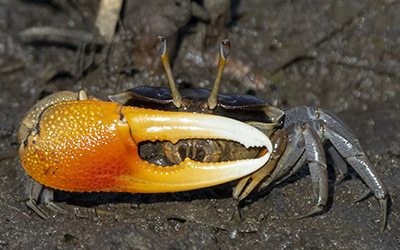
Other than front breadth, the most likely methods of distinguishing Tubuca coarctata from Paraleptuca crassipes are the shape of the tip of the large claw and the presence of the blue spots on the backs of the rear legs. Paraleptuca crassipes also leans much more heavily toward bright reds than Tubuca coarctata, whose redder forms are more orange.
Tubuca paradussumieri is a strangely variable species, but still frequently identifiable in each of its varying forms. In one common form, adults are generally a rather dull color, with a faded blue-tan carapace (sometimes light, sometimes dark) and generally yellow-tan major claw. The shape of the claw in this form is quite distinct with extremely long fingers relative to other fiddler crabs. The claw shape alone can be used to identify the species in this form.
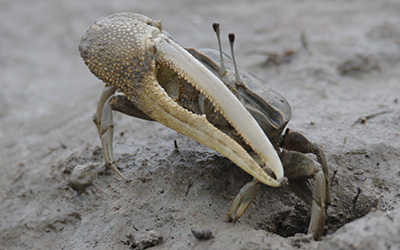
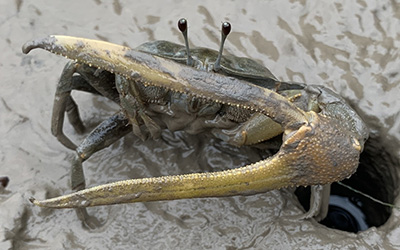
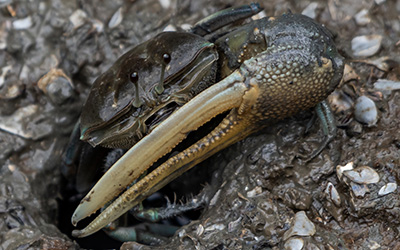
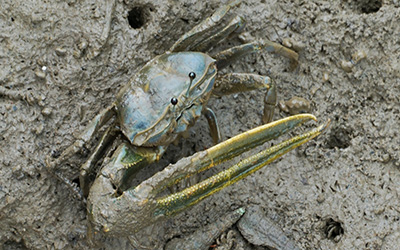
In contrast to the dull colors of these large adults, younger individuals in this species can be a brilliant cobalt blue, with much more typical-shaped claws lacking the overly long fingers. Some other related species from the genus Tubuca might also have a similar blue phase, so it is unclear how readily identifiable individuals of this shade are to the species level.
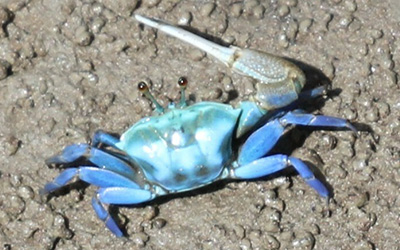
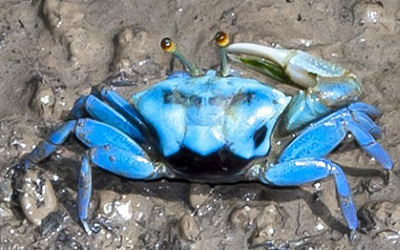
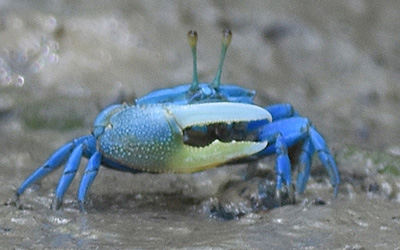
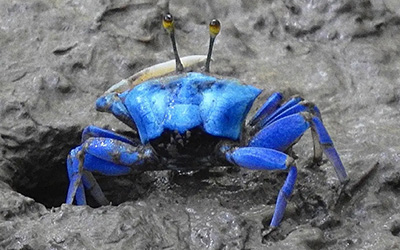
Tubuca dussumieri has a lot of similarities to both Tubuca coarctata and Tubuca paradussumieri, but lacks the extreme variability of the other two species. Tubuca dussumieri generally has a dark blue or black carapace, frequently solid colored although some spotting is possible, including occasional pale spots on the rear legs.
The large claw of male Tubuca dussumieri is generally two-toned, orange on the bottom and white on the top, with a darker orange/red patch at the base of the bottom finger. The fingers of the large claw tend to be fairly straight.
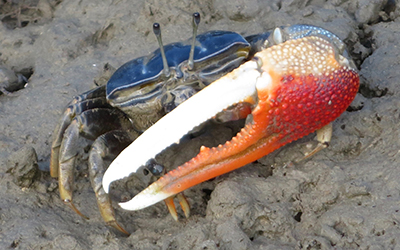
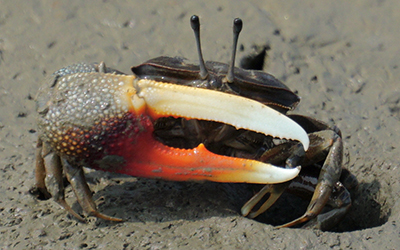
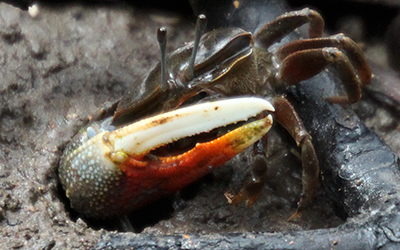
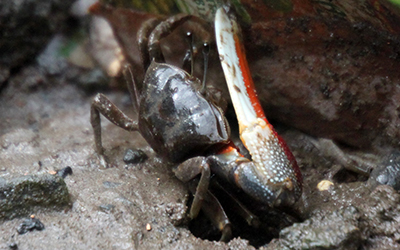
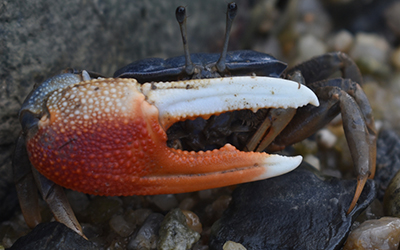
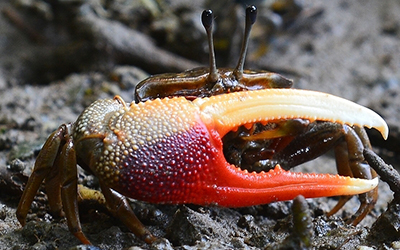
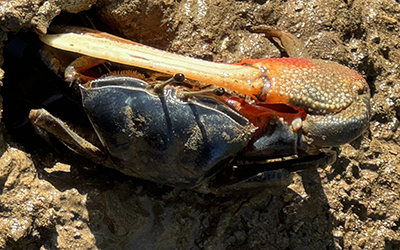
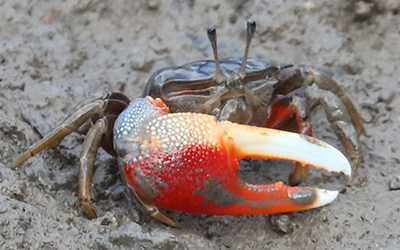
Tubuca paradussumieri is much more likely to have a large claw with the overly long fingers than Tubuca dussumieri. In general, the dark orange/red patch at the base of the lower finger in Tubuca dussumieri should be adequate to distinguish males of the two species.
A final feature that distinguishes Tubuca coarctata from both Tubuca dussumieri and Tubuca paradussumieri may be too subtle to see in most cases, but is worth mentioning. Both Tubuca dussumieri and Tubuca paradussumieri have two long grooves running across most of the length of the upper finger of the large claw; Tubuca coarctata only has one. Unfortunately, these grooves are not always readily visible, particularly as the pale upper fingers of the claw frequently appear slightly overexposed in photographs.
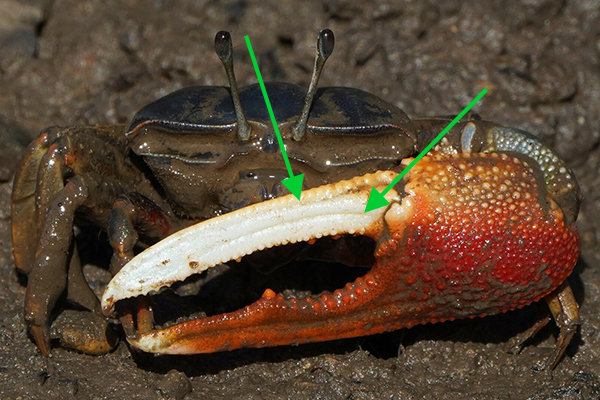
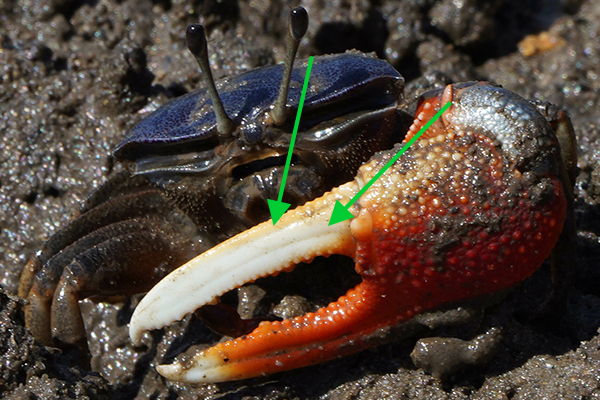
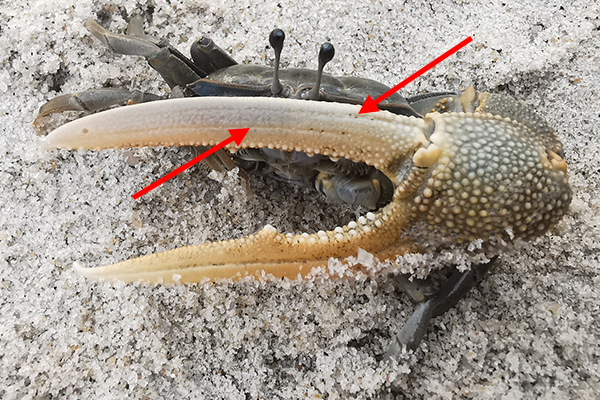
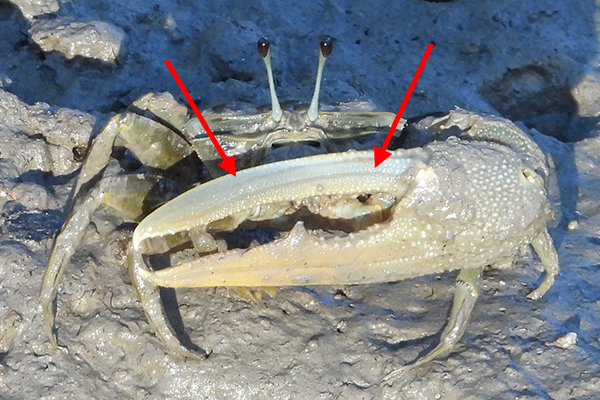
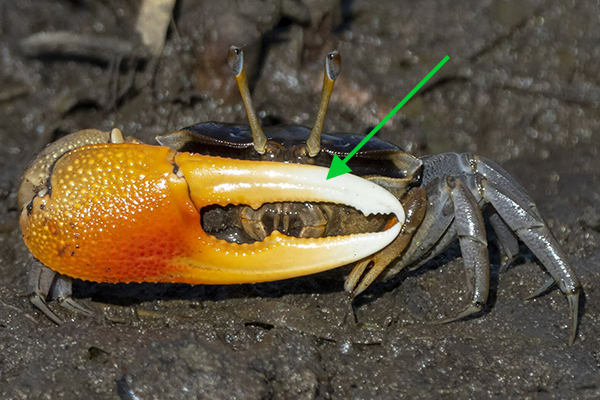
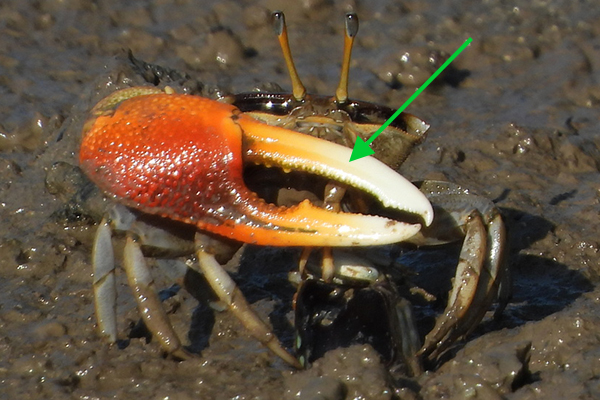
A poorly known species, Tubuca demani is either rare or frequently confused with other species. It's carapace can range from dull red to darker with pale blotches. It has red or rose eyestalks. The large claw ranges from rose red to dull purple-red to purple, frequently including the entirety of the claw and arm. The large claw is generally thick and heavy, with very straight fingers lacking the distinct projection near the tips that is frequently seen in species such as Tubuca coarctata, Tubuca rosea, or Tubuca forcipata.
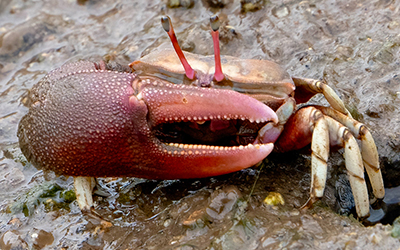
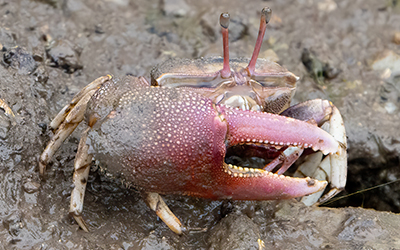
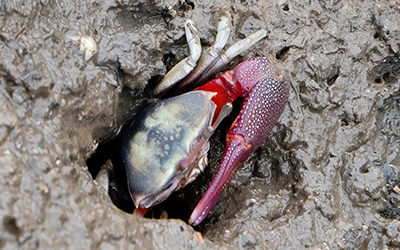
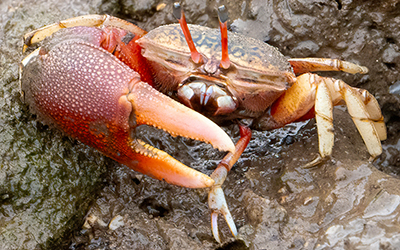
Tubuca bellator is another poorly known or rare species, but more distinct that the previous one. Its carapace is generally a mix of aqua and black, the hand of its large claw is brown with a darker orange patch near the based of the lower finger, and the fingers are entirely white and particularly smooth looking (a feature rarely seen outside of Australia and Taiwan). The lower finger has a distinct tooth-like projection, followed by a fairly straight inner edge to the tip.
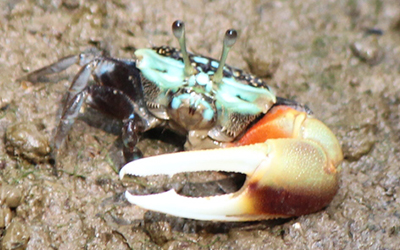
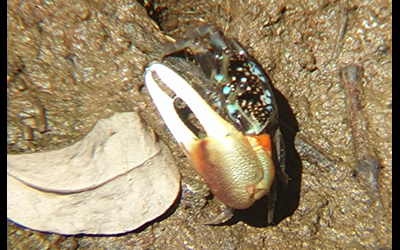
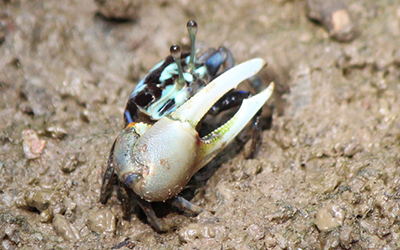
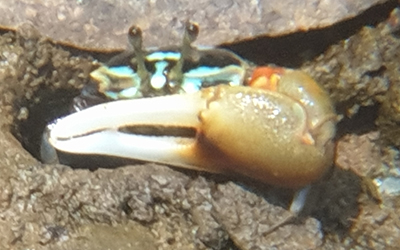
The two species from the subgenus Gelasimus (Gelasimus) are very similar to each other and may be difficult to tell apart. They can be distinguished from most other species by both color and the structure of the large claw in males. The claw has a distinct shape only found in the species of this subgenus. Specifically, the upper finger tends to be moderately broad, tapering smoothly to a point, while the lower finger will usually curve upwards with a characteristic wave on the inner surface highlighting one to two large teeth. Individuals with regenerating claws will often lack much of this shape, but the claw still looks readily different from other species in the region.
The carapace of Gelasimus vocans generally appears solidly colored or lightly marbled; the color is frequently green or dark brown or white. The lower finger of the claw is typically yellow or orange, with the upper finger white or pink. The species entirely lacks the reds and dark blues/blacks associated with the other narrow front species in the region.
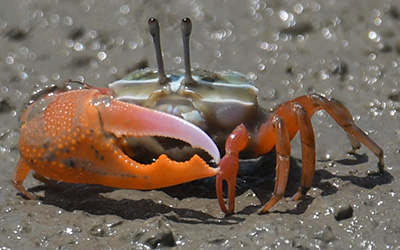
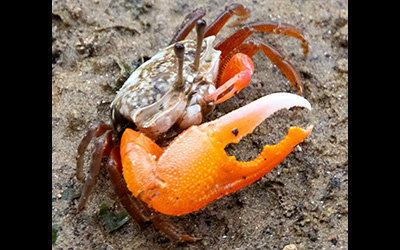
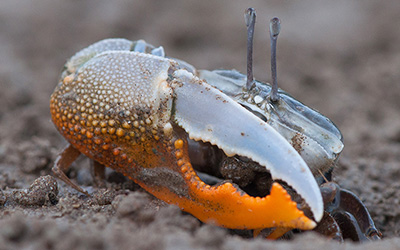
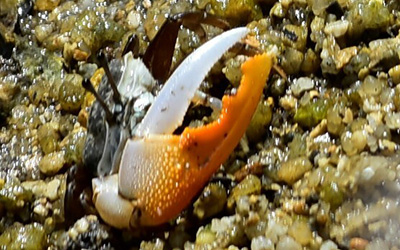
Gelasimus jocelynae is the same basic colors as Gelasimus vocans, with the primary difference being a mildly subtle difference in claw shape. While the general shape and toothiness of the claw is the same, the difference is found in the thickness of the dactyl (upper finger) of the large claw. In Gelasimus jocelynae this finger is thicker than that of the pollex (lower finger) (particularly around the first 1/3-1/2 of the finger), while in Gelasimus vocans the dactyl is the same width or thinner than the lower finger.
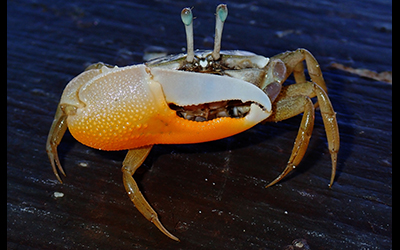
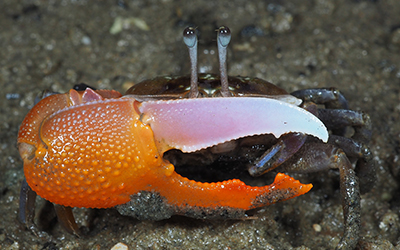

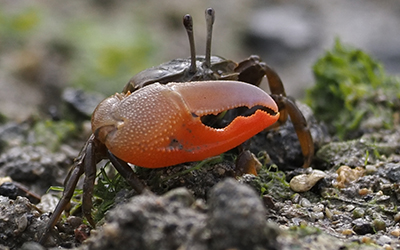
I know of no reliable way of distinguishing among females of these two species in the field.